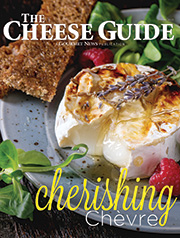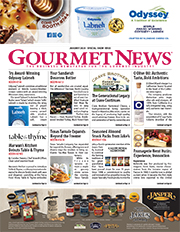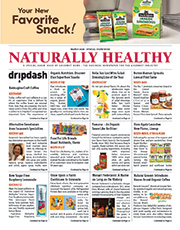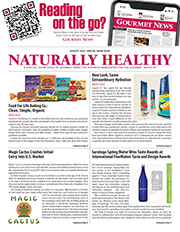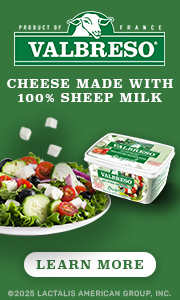Torani Urges Rinse Water Savings, Announces Internal Program
 In celebration of World Water Day, March 22, Torani, the nearly 100-year-old flavor company, announced its Rinse Water Savings Project, which has saved more than 25 percent on daily water usage. Since implementing its Rinse Water Savings Project in September 2022, Torani has saved over 3.5 million gallons of water in its manufacturing processes and expects to save a total of six million gallons in the first 12 months.
In celebration of World Water Day, March 22, Torani, the nearly 100-year-old flavor company, announced its Rinse Water Savings Project, which has saved more than 25 percent on daily water usage. Since implementing its Rinse Water Savings Project in September 2022, Torani has saved over 3.5 million gallons of water in its manufacturing processes and expects to save a total of six million gallons in the first 12 months.
As a Certified B-Corp, Torani believes business can and should be a force for good that directly impacts its people, their community, and the planet.
With an ever-expanding line of over 150 flavored syrups and sauces in which water is a key ingredient, Torani is dependent on a steady supply of clean water and is committed to scaling its water savings initiative to make an even bigger impact in 2023 and beyond.
“At Torani, we’re committed to creating impactful work and meaningful learning, growth, and development opportunities for every team member,” said Melanie Dulbecco, CEO. “When we put our people first and give them the chance to shape their work, they can address big problems and make a real impact.”
The company’s engineering team has extensively reviewed Torani’s water consumption processes over the past two years at its “Flavor Factory” headquarters in San Leandro, Calif., and identified several different ways to reduce water usage every day.
“Our team came together and set an ambitious water savings goal; this became our north star and guides all of our decisions,” said Kimberly Ear, reliability engineer. “Our Rinse Water Savings Project has proven to have a positive impact on the environment, and we’re excited that it will be a launchpad for even greater water savings in the future.”
Ear leads the Rinse Water Savings Project team, made up of 11 team members from across the company. This aspiration for implementing water savings was driven by a team of seasoned engineers who have built beverage plants in all corners of the world.
“As one of the few remaining food and beverage manufacturers in the Bay Area, we push ourselves to be even more creative and use technology to solve big challenges,” said Dulbecco. “This project is just another example of how our team members can create opportunities for themselves while impacting our community and planet.”
Water sustainability was top of mind when Torani relocated from South San Francisco to its expansive new Flavor Factory headquarters in early 2020. Since the company “soft launched” the Rinse Water Savings Project in 2022, Torani has successfully replenished over 20,000 gallons of water every day, amounting to an estimated 25 percent savings in daily water usage.
The Rinse Water Savings Project captures and reuses rinse water, utilizing it as the first rinse when cleaning tanks before the manufacturing team begins making a new syrup. In addition, Ear and the team worked to remove redundant rinses, including scaling back on double rinses while ensuring the results exceeded industry standards. Through these new rinse water processes, Torani expects to reduce the amount of water used by over six million gallons annually.
In the coming years, Torani plans to widen its sustainability efforts as it works toward becoming more energy efficient. By the end of 2023, Torani’s Flavor Factory will have a solar-powered roof that will power the entire plant’s operations. Torani will also reoptimize its lighting system and investigate additional water-saving initiatives for its wastewater.
For more news about the food and beverage industry, subscribe to Gourmet News.
Spud Art: Try a New Easter Activity, Painting Easter Potatoes
 Families love their tried-and-true Easter traditions, but sometimes, you just need to scramble things up. This year, due in part to skyrocketing food prices, Potatoes USA reports that families are hopping on the newest trend and painting Easter potatoes.
Families love their tried-and-true Easter traditions, but sometimes, you just need to scramble things up. This year, due in part to skyrocketing food prices, Potatoes USA reports that families are hopping on the newest trend and painting Easter potatoes.
You heard that right: 2023 is the year of the Easter potato.
As it turns out, there are lots of upsides to brushing up on your spud art. In addition to being an affordable, nutritious pantry staple, potatoes are an excellent canvas for family activities.
“As a mom of two kids, I’m constantly looking for new activities. The idea of painting potatoes made me laugh, but honestly, it’s really fun,” said Marisa Stein, director of marketing at Potatoes USA. “My kids loved experimenting with different designs. It was silly and a great way to spend time with my family.”
Across the internet, families are giving their best tips for family-friendly crafting, featuring everyone’s favorite vegetable. Some use edible paint and water-based food coloring to dye their potatoes and eat them, too. Artists can give potatoes a food coloring bath for a lighter color or paint the food coloring directly on the spud for a vibrant alternative.
Other families are using traditional paint from their local craft store or dollar store to paint fun decorative potatoes to showcase their artistic accomplishments. Like with carving pumpkins at Halloween, the potato’s long shelf-life makes it an excellent opportunity to display fun showpieces in a friendly painting contest.
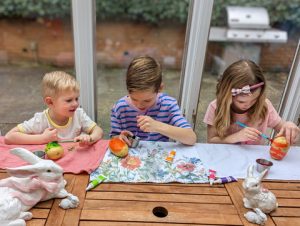 For the best results, here are a few tips for your Picasso potato:
For the best results, here are a few tips for your Picasso potato:
Cover your workspace with newspapers or plastic tablecloths so you can embrace the painting process without worrying about the cleanup.
Gloves are a great way to keep little hands clean from food dye or paint.
If you’re using food coloring, painting the food coloring on will result in the most vibrant color. If you don’t want the color to rub off, and you’re fine keeping the potatoes purely decorative, a coat of hairspray can seal the color and keep the dye from bleeding.
If you use regular paint, a white primer coat will make the colors pop!
Make sure the painted potatoes have fully dried before you move them.
For an extra activity, parents can cut the potatoes in half and carve them to make Easter stamps! Once the adults have carved the pattern, kids can paint the potato stamps and use their creations to make fun Easter-themed paintings on paper.
As an added bonus, potatoes are a great option for scavenger hunts in the backyard. The Easter Bunny doesn’t have to worry about hiding their spuds a little too well, since anything the tater hunters miss is biodegradable. (Just be sure to keep dogs away, as raw potatoes can make them sick.)
Parents are loving potatoes for their Easter activities this year due to their affordable price points and lack of prep work. Potatoes work best as an artistic medium in their natural state, so no boiling or set-up is needed to make them canvas ready. Plus, they’re tough against falls and drops for younger (and mess-prone) artists.
“I’m thrilled to see so many families hopping aboard this new trend,” said Bonnie Johnson, R.D., director of nutrition and industry relations, Potatoes USA. “As a dietitian, I love seeing families embrace vegetables in creative ways. Making potatoes a fun part of your holiday will help children learn to love the spud – and all its incredible nutritional benefits.”
In addition to their more creative side, potatoes also shine as a nutritious pantry staple. Research published in The Journal of the Academy of Nutrition and Dietetics found that potatoes have the highest score per dollar on eight important nutrients including potassium, fiber, protein, vitamins C and E, calcium, iron and magnesium. Potatoes also have a longer shelf life than many fresh vegetables.
Be sure to visit PotatoGoodness.com to learn more about the many health benefits of potatoes and find some delicious spring recipes.
If your Easter bunny hops on the #easterpotatoes trend this year, send us your photos! Tag @PotatoGoodness on Facebook or Instagram.
For more trends in food and beverage, subscribe to Gourmet News.
Hey, Football Fans: Recycle Pizza Boxes, Please!
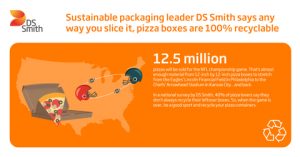 Most pizza lovers stocking up for football’s championship game know they can recycle pizza boxes, but an alarming 40 percent say they don’t always do so.
Most pizza lovers stocking up for football’s championship game know they can recycle pizza boxes, but an alarming 40 percent say they don’t always do so.
That’s the main finding of a national survey by sustainable packaging leader DS Smith, which said pizza boxes are indeed 100 percent recyclable. Pizza boxes can be easily recycled providing any crumbs and cheese are removed before they go into recyclable trash.
With 12.5 million pizzas expected to be sold on Sunday, Feb. 12, that’s almost enough material from 12-inch by 12-inch boxes to stretch from the Eagles’ Lincoln Financial Field in Philadelphia to the Chiefs’ Arrowhead Stadium in Kansas City … and back.
In the run-up to the NFL’s Big Game between those two teams, DS Smith is calling on all fans to properly recycle pizza boxes.
“We are driven to make changes both big and small in how the packaging industry operates to contribute to a more sustainable future,” said DS Smith’s Melanie Galloway, vice president, sales, marketing and innovation. “Part of that mission includes educating consumers on what they can do to be part of the solution, too, even something as simple as being sure to recycle your pizza boxes.”
The company survey, taken Jan. 27-30, found that two-thirds (67 percent) of adults believe pizza boxes are recyclable – ranking fifth among a list of popular items. Leading the way is plastic water bottles, with 88 percent of respondents saying they can be recycled. Next came newspapers or magazines (82 percent) and glass jars and milk cartons (both at 75 percent).
Even with high recognition among consumers that pizza containers should go into recyclable trash, three of five adults say they don’t always do so – with 19 percent saying they never do, 11 percent only sometimes and 10 percent rarely.
Still, a majority of those surveyed – 60 percent – respond that they recycle, with 43 percent saying they always do so and 17 percent saying most of the time.
DS Smith wants all consumers to know that pizza boxes can be recycled – important because any increase in recycling contributes to a circular economy designed to replace problem plastics, take carbon out of supply chains and prove innovative recycling solutions.
Recovered fibers can be reused as many as 10 times by paper and packaging companies to make new boxes, diverting waste from landfills and incinerators and toward local recycling facilities.
For its part, DS Smith produces a recyclable pizza pad, an insert under the pies used in boxes by major, nationally acclaimed pizza brands. The packaging company sells millions of the pads each year, recording a burst in production amid the frenzy of the football season’s final weeks.
The customizable, 100 percent recyclable pad is flat on one side, facing the bottom of the box, and wavy on the top, keeping the pizza crust crisp and dry. That so-called fluting also helps hold the temperature in the box during deliveries, DS Smith said.
The DS Smith product marks an example of the company’s renewable, fiber-based packaging solutions for hundreds of thousands of products for both traditional and e-commerce retailers, covering wine boxes and ready-meal trays to cardboard coolers and fresh fruit trays.
It marks just one of many ways that DS Smith uses innovation and imagination to create sustainable packaging solutions that support the transition to a circular economy that aims to reduce and eliminate waste and advocates for the reuse of materials.
The poll was taken Jan. 27-30 with 1,221 respondents, a total that generally has a margin of error of plus or minus 3 percentage points. It was conducted using an online data collection methodology with the research firm Dynata.
For news of interest to the foodservice industry, subscribe to Gourmet News.
